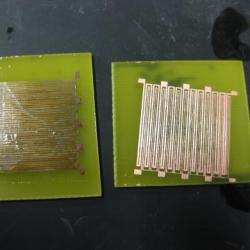Source Institutions
Source Institutions
Add to list Go to activity
Activity link broken? See if it's at the internet archive

In this activity, learners use UV light to transfer a pattern onto a plastic board. The pattern is transferred by placing a mask (a transparency sheet with the pattern) on a plastic board. The board is coated with a copper film that is covered with a light-reactive polymer (photo-resist). The polymer is exposed to UV light through the mask to make a pattern in the polymer. The metal under the exposed polymer is then chemically etched, leaving only the pattern on the surface of the board as determined by the mask. This top-down approach to nanotechnology is commonly used in manufacturing circuit boards for computers and other electronics.
- 1 to 2 hours
- 1 to 2 hours
- Over $20 per group of students
- Ages 14 - adult
- Activity, Experiment/Lab Activity, Lesson/Lesson Plan
- English
Quick Guide
Materials List (per group of students)
- UV exposure station, consisting of 2 UV lamps (black lights)
- Black cloth or big basket to cover the UV lamps
- Applicator sticks of Photoresist Stripper
- Large Beakers (plastic and glass, 500 to 750 ml)
- Small Beakers (150-250ml)7
- Glass Slides
- Tweezers (1 for each learner)
- Photomasks (electrode pattern on transparency) (1 for each learner)
- Permanent Marker
- 250 mL Glass Beakers
- Watch Glass (Beaker Cover)
- Heat resistant gloves
- Stopwatch timer
- Digital Multimeter
- Photoresist Developer
- 1 - Box of gloves (size Small)
- 1 - Box of gloves (size Medium)
- 1 - Box of gloves (size Large)
- Etching Powder (Ferric Chloride)
- Neutralizing Powder (Baking Soda, NaHCO3)
- Bag of Concrete (for disposal)
- Photoresist-coated circuit boards (1 for each learner)
- Boiling Chips
Subjects
-
Engineering and Technology
-
Engineering
- Computer Engineering
- Electrical Engineering
- Metallurgy and Materials Engineering
- Nanotechnology
- Technology
-
Engineering
-
Physical Sciences
-
Chemistry
- Chemical Reactions
-
Vibration and Waves
- Light and Optics
-
Light and Optics
- Electromagnetic Spectrum
- Sunlight and Color
-
Chemistry
-
The Nature of Science
-
The Scientific Process
- Conducting Investigations
-
The Scientific Process
-
The Nature of Technology
-
Technology and Society
- Impacts of Technology
-
Technology and Society
Informal Categories
- Computers
- Electronics
Audience
To use this activity, learners need to:
- see
- see color
- be mobile
- touch
Learning styles supported:
- Uses STEM to solve real-world problems
- Involves hands-on or lab activities
Other
Components that are part of this resource:
Includes alignment to state and/or national standards:
This resource is part of:
Access Rights:
- Free access
By:
Rights:
Funding Sources:
- National Science Foundation, 0532536
- National Science Foundation, 0940143
